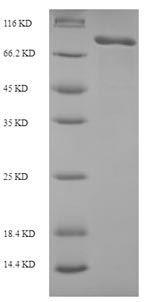Thanks for your inquiry,The concentration is determined during the manufacturing processing. The last lot's concentration is 0.3mg/ml . This product doesn't contain any preservatives.
Code: CSB-EP014783HU
Name: Recombinant Human Macrophage mannose receptor 1(MRC1),partial
Lead time: 15-20 working days.
Express region:655-1213aa Partial
Tag information: N-terminal 6xHis-SUMO-tagged
Sequence:
RTSLCFKLYAKGKHEKKTWFESRDFCRALGGDLASINNKEEQQTIWRLITASGSYHKLFWLGLTYGSPSEGFTWSDGSPVSYENWAYGEPNNYQNVEYCGELKGDPTMSWNDINCEHLNNWICQIQKGQTPKPEPTPAPQDNPPVTEDGWVIYKDYQYYFSKEKETMDNARAFCKRNFGDLVSIQSESEKKFLWKYVNRNDAQSAYFIGLLISLDKKFAWMDGSKVDYVSWATGEPNFANEDENCVTMYSNSGFWNDINCGYPNAFICQRHNSSINATTVMPTMPSVPSGCKEGWNFYSNKCFKIFGFMEEERKNWQEARKACIGFGGNLVSIQNEKEQAFLTYHMKDSTFSAWTGLNDVNSEHTFLWTDGRGVHYTNWGKGYPGGRRSSLSYEDADCVVIIGGASNEAGKWMDDTCDSKRGYICQTRSDPSLTNPPATIQTDGFVKYGKSSYSLMRQKFQWHEAETYCKLHNSLIASILDPYSNAFAWLQMETSNERVWIALNSNLTDNQYTWTDKWRVRYTNWAADEPKLKSACVYLDLDGYWKTAHCNESFYFLCK




